Advancing Integrated Fire Management and Closer-to-Nature Forest Management: A Holistic Approach to Wildfire Risk Reduction and Ecosystem Resilience in Quinta da França, Portugal
Abstract
1. Introduction
2. Fire and Forest Management at Quinta da França
2.1. Site Description
2.2. The Context of the SILVANUS Approach
2.3. Non-Grazing Interventions
2.3.1. Firebreaks
2.3.2. Mechanical Shrub Control
2.3.3. Prescribed Burning as a NbS
2.3.4. Selective Tree Pruning and Thinning
2.4. Grazing
3. Methods
3.1. Remote Sensing
3.1.1. Satellite Monitoring
3.1.2. UAV Monitoring
3.1.3. Land Cover Maps
3.1.4. Vegetation Vigour
3.1.5. Biomass Estimation
- In a given area, vegetation classes (types/species present in that area) are identified. Usually for maintenance purposes, three vegetation classes are considered: trees, shrubs, and grass.
- Vegetation volume is extracted per class, in the area, overlapping LiDAR data.
- A machine learning model is applied, making use of satellite imagery (10 × 10 m) to estimate the volume per class.
3.2. Fieldwork
3.2.1. Forest Inventories
3.2.2. Vegetation Survey
4. Results and Discussion
- Promotion of Natural Regeneration, Partially Assisted through Planting: After two major wildfires, the area of where QF’s forest currently lies underwent significant natural regeneration, with native oak, shrubs, and other vegetation returning. However, regeneration quality was hindered by factors such as the absence of mature trees and pockets of invasive species like Acacia dealbata, Acacia melanoxylon, Ailanthus altissima or Opuntia ficus-indica. To support recovery, human-assisted interventions, including thinning and pruning of the natural regeneration of oaks and targeted planting of pine and cypress saplings, have accelerated growth, stabilised soil, and improved biodiversity, bolstering ecosystem resilience.
- Partial Selective Thinning for High-Value Trees: Low-intensity thinning was employed, prioritising the retention and promotion of trees possessing the highest economic or ecological value. This meant favouring valuable, well-shaped, broadleaf trees with high market potential, while also conserving trees, aiming for the expected ecological benefits.
- Maintaining Species Diversity: A key aspect was maintaining and preserving all naturally existing tree and understory plant species. No native species were removed solely based on their identity; instead, the focus was on optimising the overall composition and structure of the forest.
- Promotion of Multi-Stratified Structure for Wildfire Resilience: The silvicultural treatments actively promoted a multi-stratified forest structure. This means creating a forest with fuel gaps, vertically and horizontally, and multiple layers of vegetation—from the understory to the canopy—rather than uniform, evenly aged, single-layered, monoculture stands. This higher forest structure and landscape complexity is strategically important for reducing the risk of large wildfires. Specifically, the layered structure breaks the continuity of fuel, reducing the ease with which fire can spread through the vegetation. Thus, fire would only play its natural ecological role.
- Selective Understory Clearing: In addition to the above, the understory vegetation was subject to partial, selective clearing. This was not a complete removal of the undergrowth but rather a targeted approach to manipulate the understory density and composition, potentially to improve light penetration for desirable species, reduce competition, or further enhance wildfire resilience by creating fuel breaks.
4.1. Overall Forest Characteristics
4.2. Grazing
4.3. Prescribed Fire
5. Conclusions
Author Contributions
Funding
Data Availability Statement
Conflicts of Interest
Correction Statement
Abbreviations
| AI | Artificial Intelligence |
| CNN | Convolutional Neural Network |
| CTNFM | Closer-to-Nature Forest Management |
| DBH | Diameter at Breast Height |
| DSS | Decision Support System |
| EO | Earth Observation |
| ESA | European Space Agency |
| EU | European Union |
| FAO | Food and Agriculture Organization of the United Nations |
| FCNN | Fully Convolutional Neural Network |
| FDI | Fire Danger Index |
| FFDN | Integrated Forest Fire Defence Network |
| FI | Forest Inventories |
| FMS | Fuel Management Strips |
| GHG | Greenhouse Gases |
| GIS | Geographic Information System |
| H | Height |
| IFM | Integrated Fire Management |
| IWRM | Integrated Wildfire Risk Management |
| LFG | Landscape Fire Governance Framework |
| LiDAR | Light Detection and Ranging |
| MAE | Mean Absolute Error |
| NbS | Nature-Based Solution |
| NDVI | Normalised Difference Vegetation Index |
| NIR | Near-Infrared |
| PPSA | Priority Prevention and Security Areas |
| PB | Prescribed Burning |
| PNDFCI | National Plan for Forest Fire Prevention and Protection |
| PUB | Prescribed Underburning |
| QF | Quinta da França |
| QGIS | Quantum GIS software |
| R2 | Coefficient of Determination |
| ResNet | Residual Network |
| RGB | Red, Green, and Blue |
| RMSE | Root Mean Squared Error |
| UAV | Unmanned Aerial Vehicle |
| UP | User Products |
| UTC | Coordinated Universal Time |
| WUI | Wildland–Urban Interface |
References
- Lee, H.; Calvin, K.; Dasgupta, D.; Krinner, G.; Mukherji, A.; Thorne, P.; Park, Y. IPCC, 2023: Climate Change 2023: Synthesis Report, Summary for Policymakers. Contribution of Working Groups I, II and III to the Sixth Assessment Report of the Intergovernmental Panel on Climate Change; Core Writing Team, Lee, H., Romero, J., Eds.; IPCC: Geneva, Switzerland, 2023. [Google Scholar] [CrossRef]
- Kalabokidis, K.; Palaiologou, P.; Xanthopoulos, G. Pyro-geography of the Greek landscape. In The Geography of Greece: Managing Crises and Building Resilience; Springer International Publishing: Cham, Switzerland, 2024; pp. 373–387. [Google Scholar] [CrossRef]
- Knutzen, F.; Averbeck, P.; Barrasso, C.; Bouwer, L.M.; Gardiner, B.; Grünzweig, J.M.; Hänel, S.; Haustein, K.; Johannessen, M.R.; Kollet, S.; et al. Impacts on and damage to European forests from the 2018–2022 heat and drought events. Nat. Hazards Earth Syst. Sci. 2025, 25, 77–117. [Google Scholar] [CrossRef]
- Heidari, H.; Arabi, M.; Warziniack, T. Effects of climate change on natural-caused fire activity in western US national forests. Atmosphere 2021, 12, 981. [Google Scholar] [CrossRef]
- Jones, M.W.; Abatzoglou, J.T.; Veraverbeke, S.; Andela, N.; Lasslop, G.; Forkel, M.; Smith, A.J.; Burton, C.; Betts, R.A.; van der Werf, G.R.; et al. Global and regional trends and drivers of fire under climate change. Rev. Geophys. 2022, 60, e2020RG000726. [Google Scholar] [CrossRef]
- Silva, P.; Carmo, M.; Rio, J.; Novo, I. Changes in the Seasonality of Fire Activity and Fire Weather in Portugal: Is the Wildfire Season Really Longer? Meteorology 2023, 2, 74–86. [Google Scholar] [CrossRef]
- Tedim, F.; Xanthopoulos, G.; Leone, V. Forest fires in Europe: Facts and challenges. In Wildfire Hazards, Risks and Disasters; Elsevier: Amsterdam, The Netherlands, 2015; pp. 77–99. [Google Scholar]
- Bar-Massada, A.; Alcasena, F.; Schug, F.; Radeloff, V.C. The wildland–urban interface in Europe: Spatial patterns and associations with socioeconomic and demographic variables. Landsc. Urban Plan. 2023, 235, 104759. [Google Scholar] [CrossRef]
- Aksoy, E.; Kocer, A.; Yilmaz, İ.; Akçal, A.N.; Akpinar, K. Assessing fire risk in wildland–urban interface regions using a machine learning method and GIS data: The example of Istanbul’s European Side. Fire 2023, 6, 408. [Google Scholar] [CrossRef]
- Taccaliti, F.; Marzano, R.; Bell, T.L.; Lingua, E. Wildland–urban interface: Definition and physical fire risk mitigation measures, a systematic review. Fire 2023, 6, 343. [Google Scholar] [CrossRef]
- Kreider, M.R.; Higuera, P.E.; Parks, S.A.; Rice, W.L.; White, N.; Larson, A.J. Fire suppression makes wildfires more severe and accentuates impacts of climate change and fuel accumulation. Nat. Commun. 2024, 15, 2412. [Google Scholar] [CrossRef] [PubMed]
- Wu, X.; Sverdrup, E.; Mastrandrea, M.D.; Wara, M.W.; Wager, S. Low-intensity fires mitigate the risk of high-intensity wildfires in California’s forests. Sci. Adv. 2023, 9, eadi4123. [Google Scholar] [CrossRef]
- Pronto, L.; Part-Guitart, N.; Caamano, J.; Alfonso, L.; Almodovar, J.; Molina, N.L.; Vendrell, J. Forest Fires of Summer 2022: Lessons to Draw from the Cohesion Policy Response; IPOL|Policy Department for Structural and Cohesion Policies: Brussels, Belgium, 2023. [Google Scholar] [CrossRef]
- Moore, P.F. Global wildland fire management research needs. Curr. For. Rep. 2019, 5, 210–225. [Google Scholar] [CrossRef]
- Food and Agriculture Organization of the United Nations. Global Fire Management Hub. 2024. Available online: https://www.fao.org/forestry/firemanagement/projects/project-detail/global-fire-management-hub/en (accessed on 9 July 2024).
- Rego, F.C.; Morgan, P.; Fernandes, P.; Hoffman, C. Fire Science: From Chemistry to Landscape Management; Springer: Berlin/Heidelberg, Germany, 2021. [Google Scholar] [CrossRef]
- Rego, F.; Fernandes, P.; Rigolot, E. Towards Integrated Fire Management: Outcomes of the European Project Fire Paradox; No. 23; Silva, J.S., Ed.; European Forest Institute: Joensuu, Finland, 2010; pp. 35–112. [Google Scholar]
- Myers, R.L. Living with Fire: Sustaining Ecosystems & Livelihoods Through Integrated Fire Management; The Nature Conservancy, Global Fire Initiative: Arlington, VA, USA, 2006; Available online: https://www.cbd.int/doc/pa/tools/Living%20with%20Fire.pdf (accessed on 15 May 2025).
- Kalapodis, N.; Sakkas, G. Integrated fire management and closer to nature forest management at the landscape scale as a holistic approach to foster forest resilience to wildfires. Open Res. Eur. 2025, 4, 131. [Google Scholar] [CrossRef]
- European Commission. New EU Forest Strategy for 2030; COM(2021) 572 Final; European Commission: Brussels, Belgium, 2021; Available online: https://eur-lex.europa.eu/legal-content/EN/TXT/?uri=CELEX%3A52021DC0572 (accessed on 15 May 2025).
- European Commission. The European Green Deal; COM(2019) 640 Final; European Commission: Brussels, Belgium, 2019; Available online: https://eur-lex.europa.eu/legal-content/EN/TXT/?uri=CELEX:52019DC0640 (accessed on 15 May 2025).
- Casartelli, V.; Mysiak, J. Union Civil Protection Mechanism—Peer Review Programme for Disaster Risk Management: Wildfire Peer Review Assessment Framework (Wildfire PRAF); European Union: Brussels, Belgium, 2023; Available online: https://civil-protection-humanitarian-aid.ec.europa.eu/document/download/d61050aa-9716-471b-8579-09df502fbef4_en?filename=Wildfire_PRAF_V2.pdf (accessed on 15 May 2025).
- AGIF—Agência para a Gestão Integrada do Fogo Rural. Landscape Fire Governance Framework. 2023. Available online: https://www.wildfire2023.pt/conference/framework (accessed on 2 May 2025).
- Stoof, C.R.; Valkó, O.; Aakala, T.; Arca, B.; Arsava, K.S.; Ascoli, D.; Bengtsson, J.; Engelbrecht, J.; Fra Paleo, U.; Marinšek, A.; et al. Changing Wildfires: Policy Options for a Fire-Literate and Fire-Adapted Europe; (EASAC Policy Report); EASAC Secretariat c/o Austrian Academy of Sciences: Vienna, Austria, 2025; Available online: https://easac.eu/publications/details/changing-wildfires (accessed on 15 May 2025).
- European Commission, Directorate-General for Environment. Guidelines on Closer-to-Nature Forest Management; SWD(2023) 284 Final; Publications Office of the European Union: Luxembourg, 2023; Available online: https://environment.ec.europa.eu/publications/guidelines-closer-nature-forest-management_en (accessed on 15 May 2025).
- Larsen, J.B.; Angelstam, P.; Bauhus, J.; Carvalho, J.F.; Diaci, J.; Dobrowolska, D.; Gazda, A.; Gustafsson, L.; Krumm, F.; Knoke, T.; et al. Closer-to-Nature Forest Management. From Science to Policy 12; European Forest Institute: Joensuu, Finland, 2022; Volume 12, pp. 1–54. [Google Scholar] [CrossRef]
- Carey, H.; Schuman, M. Modifying Wildfire Behavior—The Effectiveness of Fuel Treatments: The Status of Our Knowledge; National Community Forestry Center, Southwest Region Working Paper No. 2; National Community Forestry Center: Parramatta, NSW, Australia, 2003; Available online: https://energyjustice.net/biomass/library/Carey-Schumann.pdf (accessed on 15 May 2025).
- Graham, R.T.; McCaffrey, S.; Jain, T.B. Science Basis for Changing Forest Structure to Modify Wildfire Behavior and Severity; Gen. Tech. Rep. RMRS-GTR-120; U.S. Department of Agriculture, Forest Service, Rocky Mountain Research Station: Fort Collins, CO, USA, 2004; 43p. Available online: https://research.fs.usda.gov/treesearch/6279 (accessed on 15 May 2025).
- Piqué, M.; Castellnou, M.; Valor, T.; Pagés, J.; Larrañaga, A.; Miralles, M.; Cervera, T. Integració del Risc de Grans Incendis Forestals (GIF) en la Gestió Forestal: Incendis Tipus i Vulnerabilitat de les Estructures Forestals al foc de Capçades; Sèrie: Orientacions de Gestió Forestal Sostenible per a Catalunya—ORGEST, No. 118; Centre de la Propietat Forestal, Departament d’Agricultura, Ramaderia, Pesca, Alimentació i Medi Natural, Generalitat de Catalunya: Barcelona, Spain, 2011. [Google Scholar]
- Piqué, M.; Valor, T.; Beltrán, M. Reducing vulnerability to wildfires at forest stand level. In Operational Tools and Guidelines for Improving Efficiency in Wildfire Risk Reduction in EU Landscapes; CTFC ed.; Plana, E., Font, M., Green, T., Eds.; FIREfficient Project; CTFC Editions (Forest Sciences Centre of Catalonia): Solsona, Spain, 2015; p. 88. [Google Scholar]
- Kalapodis, N.; Sakkas, G.; Lazarou, A.; Casciano, D.; Demestichas, K.; Athanasiou, M.; Kaloudis, S.; Sykas, D. EU-Integrated Multifunctional Forest and Fire Management, Policies, and Practices: Challenges Between “As-Is” and “To-Be” State. In Paradigms on Technology Development for Security Practitioners; Springer Nature Switzerland: Cham, Switzerland, 2024; pp. 65–77. [Google Scholar] [CrossRef]
- Kalapodis, N.G. Reorientação da Gestão Florestal na Grécia com Relação à Gestão Florestal Multifuncional, Orientada para a Natureza e Ambientalmente Adaptável. Ph.D. Thesis, Albert-Ludwigs-University Freiburg, Breisgau, Germany, 2010. [Google Scholar]
- Kalapodis, N.G. Close to nature forestry in order to reduce the risk of natural disasters. In Proceedings of the 14th Hellenic Forestry Congress, Patra, Greece, 4–7 October 2009. [Google Scholar]
- Mairota, P.; Manetti, M.C.; Amorini, E.; Pelleri, F.; Terradura, M.; Frattegiani, M.; Savini, P.; Grohmann, F.; Mori, P.; Terzuolo, P.; et al. Opportunities for coppice management at the landscape level: The Italian experience. IFOREST 2016, 9, 775–782. [Google Scholar] [CrossRef]
- Brang, P.; Spathelf, P.; Larsen, J.B.; Bauhus, J.; Boncčìna, A.; Chauvin, C.; Drössler, L.; García-Güemes, C.; Heiri, C.; Kerr, G.; et al. Suitability of close-to-nature silviculture for adapting temperate European forests to climate change. For. Int. J. For. Res. 2014, 87, 492–503. [Google Scholar] [CrossRef]
- Schütz, J.P. Der Plenterwald und Weitere Formen Strukturierter und Gemischter Wälder; Parey Verlag: Berlin, Germany, 2001; 207p. [Google Scholar]
- Silva, J.S.; Moreira, F.; Vaz, P.; Catry, F.; Godinho-Ferreira, P. Assessing the relative fire proneness of different forest types in Portugal. Plant Biosyst. 2009, 143, 597–608. [Google Scholar] [CrossRef]
- González, J.R.; Pukkala, T. Characterization of forest fires in Catalonia (north-east Spain). Eur. J. For. Res. 2007, 126, 421–429. [Google Scholar] [CrossRef]
- Hély, C.; Bergeron, Y.; Flannigan, M.D. Effects of stand composition on fire hazard in mixed-wood Canadian boreal forest. J. Veg. Sci. 2000, 11, 813–824. [Google Scholar] [CrossRef]
- Corona, P.; Ascoli, D.; Barbati, A.; Bovio, G.; Colangelo, G.; Elia, M.; Garfì, V.; Iovino, F.; Lafortezza, R.; Leone, V.; et al. Integrated forest management to prevent wildfires under Mediterranean environments. Ann. Silvic. Res. 2015, 39, 1–22. [Google Scholar]
- Neidermeier, A.N.; Zagaria, C.; Pampanoni, V.; West, T.A.P.; Verburg, P.H. Mapping opportunities for the use of land management strategies to address fire risk in Europe. J. Environ. Manag. 2023, 346, 118941. [Google Scholar] [CrossRef]
- North, M.; Hurteau, M.; Innes, J. Fire suppression and fuels treatment effects on mixed-conifer carbon stocks and emissions. Ecol. Appl. 2009, 19, 1385–1396. [Google Scholar] [CrossRef]
- Foster, D.E.; Battles, J.J.; Collins, B.M.; York, R.A.; Stephens, S.L. Potential wildfire and carbon stability in frequent-fire forests in the Sierra Nevada: Trade-offs from a long-term study. Ecosphere 2020, 11, e03198. [Google Scholar] [CrossRef]
- California Department of Forestry and Fire Protection [CAL FIRE]. Fuel Reduction. 2022. Available online: https://www.fire.ca.gov/what-we-do/natural-resource-management/fuels-reduction (accessed on 6 June 2025).
- Catry, F.X.; Pausas, J.G.; Moreira, F.; Fernandes, P.M.; Rego, F. Post-fire response variability in Mediterranean Basin tree species in Portugal. Int. J. Wildland Fire 2013, 22, 919–932. [Google Scholar] [CrossRef]
- Marañón, T.; Pérez-Ramos, I.M.; Villar Montero, R.; Acácio, V.; Aranda, I.; Camarero, J.J.; Valbuena-Carabaña, M. Iberian oaks coping with global change: Ecological processes and management strategies. In Quercus: Classification, Ecology and Uses; Steffensen, B.J., Ed.; Nova Science Publishers: New York, NY, USA, 2020; pp. 1–84. [Google Scholar]
- Dimitrakopoulos, A.P.; Papaioannou, K.K. Flammability assessment of Mediterranean forest fuels. Fire Technol. 2001, 37, 143–152. [Google Scholar] [CrossRef]
- Balata, D.; Gama, I.; Domingos, T.; Proença, V. Using satellite NDVI time-series to monitor grazing effects on vegetation productivity and phenology in heterogeneous Mediterranean forests. Remote Sens. 2022, 14, 2322. [Google Scholar] [CrossRef]
- Sykas, D.; Zografakis, D.; Demestichas, K.; Costopoulou, C.; Kosmidis, P. EO4WildFires: An Earth observation multi-sensor, time-series machine-learning-ready benchmark dataset for wildfire impact prediction (1.0) [Data set]. In Proceedings of the Ninth International Conference on Remote Sensing and Geoinformation of Environment (RSCy2023), Ayia Nap, Cyprus, 3–5 April 2023. [Google Scholar] [CrossRef]
- Markarian, G.; Sakkas, G.; Kalapodis, N.; Chandramouli, K.; Marić, L. Utilisation of unmanned aerial vehicles and mesh in the sky wireless communication system in wildfire management. In Proceedings of the 2024 IEEE International Geoscience and Remote Sensing Symposium (IGARSS), Athens, Greece, 7–12 July 2024; pp. 2077–2081. [Google Scholar] [CrossRef]
- Zelenka, J.; Kasanicky, T.; Gatial, E.; Balogh, Z.; Majlingova, A.; Brodrechtova, Y.; Rehák, R.; Semet, Y.; Boussu, G. Coordination of drones swarm for wildfires monitoring. In Proceedings of the 20th Annual Global Conference on Information Systems for Crisis Response and Management (ISCRAM 2023), Omaha, NE, USA, 28–31 May 2023. [Google Scholar]
- Laksito, A.D.; Kusrini, K.; Setyanto, A.; Johari, M.Z.F.; Maruf, Z.R.; Yuana, K.A.; Adninda, G.B.; Kartikakirana, R.A.; Nucifera, F.; Widayani, W.; et al. Machine learning and social media harvesting for wildfire prevention. In Proceedings of the 2023 IEEE 13th International Conference on Pattern Recognition Systems (ICPRS), Guayaquil, Ecuador, 4–7 July 2023; pp. 1–6. [Google Scholar] [CrossRef]
- Balogh, Z.; Gatial, E.; Dolatabadi, S.H.; Dlugolinský, Š.; Saltarella, M.; Scipioni, M.P.; Grunwald, D.; Przybyszewski, M.; Majlingova, A.; Majlingova, Y.; et al. Communication Protocol for using Nontraditional Information Sources between First Responders and Citizens during Wildfires. In Proceedings of the 20th International ISCRAM Conference, Omaha, NE, USA, 28–31 May 2023; pp. 152–165. Available online: https://idl.iscram.org/files/balogh/2023/2514_Balogh_etal2023.pdf (accessed on 15 May 2025).
- Yuana, K.A.; Setyanto, A.; Laksito, A.D.; Maruf, Z.R.; Johari, M.Z.F.; Adninda, G.B.; Kartikakirana, R.A.; Suprapto, R.A.; Mimboro, P.; Widayani, W. Monte Carlo method for map area calculation in wildland fire map management. In Proceedings of the 2022 6th International Conference on Information Technology, Information Systems and Electrical Engineering (ICITISEE), Yogyakarta, Indonesia, 13–14 December 2022; pp. 14–17. [Google Scholar] [CrossRef]
- Yuana, K.A.; Kusrini, K.; Setyanto, A.; Laksito, A.D.; Maruf, Z.R.; Johari, M.Z.F.; Adninda, G.B.; Kartikakirana, R.A.; Suprapto, R.A.; Mimboro, P.; et al. GIS data support technique for forest fire management and decision support system: A Sebangau National Park, Kalimantan case. In Proceedings of the 2023 6th International Conference on Information and Communications Technology (ICOIACT), Yogyakarta, Indonesia, 10 November 2023; pp. 286–291. [Google Scholar] [CrossRef]
- Grant, M.A.; Duff, T.J.; Penman, T.D.; Pickering, B.J.; Cawson, J.G. Mechanical mastication reduces fuel structure and modelled fire behaviour in Australian shrub encroached ecosystems. Forests 2021, 12, 812. [Google Scholar] [CrossRef]
- Cawson, J.G.; Duff, T.J.; Penman, T.D. Long-term response of fuel to mechanical mastication in south-eastern Australia. Fire 2022, 5, 76. [Google Scholar] [CrossRef]
- Dell, J.R.; Ward, F.R. Reducing Fire Hazard in Ponderosa Pine Thinning Slash by Mechanical Crushing. U.S. Forest Service, PSW-RP-57. 1969. Available online: https://research.fs.usda.gov/treesearch/28631 (accessed on 15 May 2025).
- Volkova, L.; Weston, C.J. Effect of thinning and burning fuel reduction treatments on forest carbon and bushfire fuel hazard in Eucalyptus sieberi forests of south-eastern Australia. Sci. Total Environ. 2019, 694, 133708. Available online: https://pubmed.ncbi.nlm.nih.gov/31398652/ (accessed on 15 May 2025). [CrossRef] [PubMed]
- Fernandes, P.M.; Botelho, H.S. Effectiveness of mechanical thinning and prescribed burning on fire behavior in Pinus nigra forests in NE Spain. For. Ecol. Manag. 2017, 406, 1–8. Available online: https://pubmed.ncbi.nlm.nih.gov/29111258/ (accessed on 15 May 2025).
- Lasanta, T.; Khorchani, M.; Pérez-Cabello, F.; Errea, P.; Sáenz-Blanco, R.; Nadal-Romero, E. Clearing shrubland and extensive livestock farming: Active prevention to control wildfires in the Mediterranean mountains. J. Environ. Manag. 2018, 227, 256–266. [Google Scholar] [CrossRef] [PubMed]
- Pádua, L.; Castro, J.P.; Castro, J.; Sousa, J.J.; Castro, M. Assessing the Impact of Clearing and Grazing on Fuel Management in a Mediterranean Oak Forest through Unmanned Aerial Vehicle Multispectral Data. Drones 2024, 8, 364. [Google Scholar] [CrossRef]
- Brodie, E.G.; Knapp, E.E.; Brooks, W.R.; Drury, S.A.; Ritchie, M.W. Forest thinning and prescribed burning treatments reduce wildfire severity and buffer the impacts of severe fire weather. Fire Ecol. 2024, 20, 17. [Google Scholar] [CrossRef]
- Vilà-Vilardell, L.; De Cáceres, M.; Piqué, M.; Casals, P. Prescribed fire after thinning increased resistance of sub-Mediterranean pine forests to drought events and wildfires. For. Ecol. Manag. 2023, 527, 120602. [Google Scholar] [CrossRef]
- Reiner, A.L.; Vaillant, N.M.; Fites-Kaufman, J.; Dailey, S.N. Mastication and prescribed fire impacts on fuels in a 25-year old ponderosa pine plantation, southern Sierra Nevada. For. Ecol. Manag. 2009, 258, 2365–2372. [Google Scholar] [CrossRef]
- Busse, M.D.; Hubbert, K.R.; Fiddler, G.O. Lethal soil heating during burning of masticated forest residues. Int. J. Wildland Fire 2009, 18, 761–776. [Google Scholar] [CrossRef]
- Xing, J.; Yuan, Z.; Fu, S.; Wu, D.; Li, G. Fine woody debris retention improves soil microbial carbon dynamics in urban spruce plantations. Forests 2025, 16, 434. [Google Scholar] [CrossRef]
- Kane, J.M.; Varner, J.M.; Hiers, J.K. The burning characteristics of masticated fuels: A laboratory study. Fire Ecol. 2009, 5, 15–29. [Google Scholar]
- Keesstra, S.; Lebelt, L.; Castellani, C.; Breil, M.; Akujärvi, A.; Pellens, N.; Rooij, B.; Minnen, J.; Cristiano, W.; Zimmer, D. Nature-Based Solutions to Address Forest Disturbances Under Climate Change: The Case of Fire and Pests; ETC-CA, LULUCF, Eds.; EEA: Copenhagen, Denmark, 2024; pp. 1–95. [Google Scholar]
- Pais, S.; Aquilué, N.; Honrado, J.P.; Fernandes, P.M.; Regos, A. Optimizing Wildfire Prevention through the Integration of Prescribed Burning into ‘Fire-Smart’Land-Use Policies. Fire 2023, 6, 457. [Google Scholar] [CrossRef]
- Alcasena, F.J.; Ager, A.A.; Salis, M.; Day, M.A.; Vega-Garcia, C. Optimizing prescribed fire allocation for managing fire risk in central Catalonia. Sci. Total Environ. 2018, 621, 872–885. [Google Scholar] [CrossRef] [PubMed]
- Hueso-González, P.; Martínez-Murillo, J.F.; Ruiz-Sinoga, J.D. Prescribed fire impacts on soil properties, overland flow and sediment transport in a Mediterranean forest: A 5 year study. Sci. Total Environ. 2018, 636, 1480–1489. [Google Scholar] [CrossRef] [PubMed]
- OECD. Taming Wildfires in the Context of Climate Change: The Case of Portugal; OECD Environment Policy Papers No. 37; OECD Publishing: Paris, France, 2023. [Google Scholar] [CrossRef]
- Fernandes, P.M. Scientific support to prescribed underburning in southern Europe: What do we know? Sci. Total Environ. 2018, 630, 340–348. [Google Scholar] [CrossRef]
- Catalanotti, A.E.; Rutigliano, F.A. Effects of Prescribed Burning on Soil and Vegetation. Ph.D. Thesis, University of Naples Federico II, Naples, Italy, 2009. [Google Scholar]
- De Oliveira, E.; Sequeira, A.; Fernandes, P.; Colaço, M. The Use of Vegetation Fire in Portugal: Historical Legislative and Normative Analysis. Environ. Hist. 2025, 31, 15–39. [Google Scholar] [CrossRef]
- Fernández-Guisuraga, J.M.; Fernandes, P.M. Prescribed burning mitigates the severity of subsequent wildfires in Mediterranean shrublands. Fire Ecol. 2024, 20, 4. [Google Scholar] [CrossRef]
- Francos, M.; Colino-Prieto, F.; Sánchez-García, C. How Mediterranean ecosystem deals with wildfire impact on soil ecosystem services and functions: A review. Land 2024, 13, 407. [Google Scholar] [CrossRef]
- Hesseln, H. The economics of prescribed burning: A research review. For. Sci. 2000, 46, 322–334. [Google Scholar] [CrossRef]
- Hunter, M.E.; Taylor, M.H. The economic value of fuel treatments: A review of the recent literature for fuel treatment planning. Forests 2022, 13, 2042. [Google Scholar] [CrossRef]
- Burrows, N.; McCaw, L. Prescribed burning in southwestern Australian forests. Front. Ecol. Environ. 2013, 11, 25–34. [Google Scholar] [CrossRef]
- Ryan, K.C.; Knapp, E.E.; Varner, J.M. Prescribed fire in North American forests and woodlands: History, current practice, and challenges. Front. Ecol. Environ. 2013, 11, e15–e24. [Google Scholar] [CrossRef]
- Dems, C.L.; Taylor, A.H.; Smithwick, E.A.H.; Kreye, J.K.; Kaye, M.W. Prescribed fire alters structure and composition of a mid-Atlantic oak forest up to eight years after burning. Fire Ecol. 2021, 17, 10. [Google Scholar] [CrossRef]
- Kupfer, J.A.; Lackstrom, K.; Grego, J.M.; Dow, K.; Terando, A.J.; Hiers, J.K. Prescribed fire in longleaf pine ecosystems: Fire managers’ perspectives on priorities, constraints, and future prospects. Fire Ecol. 2022, 18, 27. [Google Scholar] [CrossRef]
- Baeza, M.J.; De Luís, M.; Raventós, J.; Escarré, A. Factors influencing fire behaviour in shrublands of different stand ages and the implications for using prescribed burning to reduce wildfire risk. J. Environ. Manag. 2002, 65, 199–208. [Google Scholar] [CrossRef] [PubMed]
- Oikonomou, D.; Vrahnakis, M.; Yiakoulaki, M.; Xanthopoulos, G.; Kazoglou, Y. Grazing as a management tool in Mediterranean Pastures: A meta-analysis based on a literature review. Land 2023, 12, 1290. [Google Scholar] [CrossRef]
- Schaffhauser, A.; Curt, T.; Vela, E.; Tatoni, T. Recurrent fires and environment shape the vegetation in Quercus suber L. woodlands and maquis. C. R. Biol. 2012, 335, 424–434. [Google Scholar] [CrossRef]
- Calvo, L.; Tarrega, R.; Luis, E. Regeneration in Quercus pyrenaica ecosystems after surface fires. Int. J. Wildland Fire 1991, 1, 205–210. [Google Scholar] [CrossRef]
- Ribeiro, I.; Domingos, T.; McCracken, D.; Proença, V. Evaluating domestic herbivores for vegetation structure management in transitional woodland–shrubland systems. Forests 2024, 15, 2258. [Google Scholar] [CrossRef]
- Moreira, F.; Pe’er, G. Agricultural policy can reduce wildfires. Science 2018, 359, 1001. [Google Scholar] [CrossRef] [PubMed]
- Rouet-Leduc, J.; Pe’er, G.; Moreira, F.; Bonn, A.; Helmer, W.; Shahsavan Zadeh, S.A.; Zizka, A.; van der Plas, F. Effects of large herbivores on fire regimes and wildfire mitigation. J. Appl. Ecol. 2021, 58, 2690–2702. [Google Scholar] [CrossRef]
- Ribeiro, I.; Domingos, T.; McCracken, D.; Proença, V. The use of domestic herbivores for ecosystem management in Mediterranean landscapes. Glob. Ecol. Conserv. 2023, 46, e02577. [Google Scholar] [CrossRef]
- Proença, V.; Ribeiro, I.; Simões, M.; Paulo, O.; Bernardino, S.; Santos Silva, C. Implementação Custo-Eficiente de Mosaicos Silvopastoris de Carvalho Negral—Relatório Não Técnico [in Portuguese]. Terraprima, UNAC, FCUL, MARETEC/IST. 2022. Available online: https://www.terraprima.pt/pt/projecto/23 (accessed on 15 May 2025).
- Trencanová, B.; Proença, V.; Bernardino, A. Development of semantic maps of vegetation cover from UAV images to support planning and management in fine-grained fire-prone landscapes. Remote Sens. 2022, 14, 1262. [Google Scholar] [CrossRef]
- Drusch, M.; Del Bello, U.; Carlier, S.; Colin, O.; Fernandez, V.; Gascon, F.; Hoersch, B.; Isola, C.; Laberinti, P.; Martimort, P.; et al. Sentinel-2: ESA’s optical high-resolution mission for GMES operational services. Remote Sens. Environ. 2012, 120, 25–36. [Google Scholar] [CrossRef]
- ESA. Sentinel-2. Available online: https://www.esa.int/Applications/Observing_the_Earth/Copernicus/Sentinel-2 (accessed on 15 May 2025).
- Hoek van Dijke, A.J.; Mallick, K.; Teuling, A.J.; Schlerf, M.; Machwitz, M.; Hassler, S.K.; Blume, T.; Herold, M. Does the normalized difference vegetation index explain spatial and temporal variability in sap velocity in temperate forest ecosystems? Hydrol. Earth Syst. Sci. 2019, 23, 2077–2091. [Google Scholar] [CrossRef]
- Cherif, E.K.; Lucas, R.; Ait Tchakoucht, T.; Gama, I.; Ribeiro, I.; Domingos, T.; Proença, V. Predicting fractional shrub cover in heterogeneous Mediterranean landscapes using machine learning and Sentinel-2 imagery. Forests 2024, 15, 1739. [Google Scholar] [CrossRef]
- Rouse, J.W.; Haas, R.H., Jr.; Schell, J.A.; Deering, D.W. Monitoring vegetation systems in the Great Plains with ERTS. In Proceedings of the Third Earth Resources Technology Satellite-1 Symposium; NASA Goddard Space Flight Center 3d ERTS-1 Symp.; NASA: Washington, DC, USA, 1974; Volume 1, Sect. A. Available online: https://ntrs.nasa.gov/api/citations/19740022614/downloads/19740022614.pdf (accessed on 15 May 2025).
- Yengoh, G.T.; Dent, D.; Olsson, L.; Tengberg Compton, A.E.; Tucker, J.T., III. Use of the Normalized Difference Vegetation Index (NDVI) to Assess Land Degradation at Multiple Scales: Current Status, Future Trends, and Practical Considerations; Springer International Publishing: Berlin/Heidelberg, Germany, 2015; Available online: http://www.springer.com/series/8868 (accessed on 15 May 2025).
- Rezaei, R.; Ghaffarian, S. Monitoring forest resilience dynamics from very high-resolution satellite images in case of multi-hazard disaster. Remote Sens. 2021, 13, 4176. [Google Scholar] [CrossRef]
- Turubanova, S.; Potapov, P.; Krylov, A.; Tyukavina, A.; McCarty, J.L.; Radeloff, V.C.; Hansen, M.C. Using the Landsat data archive to assess long-term regional forest dynamics assessment in Eastern Europe, 1985–2012. ISPRS Arch. 2015, 40, 531–537. [Google Scholar] [CrossRef]
- Verbesselt, J.; Umlauf, N.; Hirota, M.; Holmgren, M.; Van Nes, E.H.; Herold, M.; Zeileis, A.; Scheffer, M. Remotely sensed resilience of tropical forests. Nat. Clim. Change 2016, 6, 1028–1031. [Google Scholar] [CrossRef]
- Renewables Grid Initiative (RGI). Implementing Integrated Vegetation Management Across Europe; Renewables Grid Initiative: Berlin, Germany, 2023; 23p. [Google Scholar]
- Sousa, E. Florestas Maduras: Avaliação de bosques de Quercus pyrenaica na região da Terra Fria. Master’s Thesis, Instituto Politécnico de Bragança, Bragança Portugal, December 2024. [Google Scholar]
- Cañellas, I.; Sánchez-González, M.; Bogino, S.M.; Adame, P.; Herrero, C.; Roig, S.; Tomé, M.; Paulo, J.A.; Bravo, F. Silviculture and carbon sequestration in Mediterranean oak forests. In Managing Forest Ecosystems: The Challenge of Climate Change; Springer: Berlin/Heidelberg, Germany, 2008; pp. 317–338. [Google Scholar] [CrossRef]
- Nunes, L.; Magalhães, M.; Patrício, M.S.; Luís, J.F.; Rego, F.; Lopes, D. Avaliação da produção primária líquida em povoamentos puros e mistos de Quercus pyrenaica Willd. e Pinus pinaster L. no Distrito de Vila Real. Silva Lusit. 2010, 18, 27–38. [Google Scholar]
- Teague, R.; Kreuter, U. Managing grazing to restore soil health, ecosystem function, and ecosystem services. Front. Sustain. Food Syst. 2020, 4, 534187. [Google Scholar] [CrossRef]
- Bugalho, M.N.; Lecomte, X.; Gonçalves, M.; Caldeira, M.C.; Branco, M. Establishing grazing and grazing-excluded patches increases plant and invertebrate diversity in a Mediterranean oak woodland. For. Ecol. Manag. 2011, 261, 2133–2139. [Google Scholar] [CrossRef]
- Wolański, P.; Bobiec, A.; Ortyl, B.; Makuch-Pietraś, I.; Czarnota, P.; Ziobro, J.; Korol, M.; Havryliuk, S.; Paderewski, J. The importance of livestock grazing at woodland-grassland interface in the conservation of rich oakwood plant communities in temperate Europe. Biodivers. Conserv. 2021, 30, 741–760. [Google Scholar] [CrossRef]
- Oom, D.; de Rigo, D.; Pfeiffer, H.; Branco, A.; Ferrari, D.; Grecchi, R.; Artés-Vivancos, T.; Houston Durrant, T.; Boca, R.; Maianti, P.; et al. Pan-European Wildfire Risk Assessment; Tech. Rep. No. EUR 31160 EN; Publications Office of the European Union: Luxembourg, 2022. [Google Scholar] [CrossRef]
- Chuvieco, E.; Yebra, M.; Martino, S.; Thonicke, K.; Gómez-Giménez, M.; San-Miguel, J.; Oom, D.; Velea, R.; Mouillot, F.; Molina, J.R.; et al. Towards an integrated approach to wildfire risk assessment: When, where, what and how may the landscapes burn. Fire 2023, 6, 215. [Google Scholar] [CrossRef]
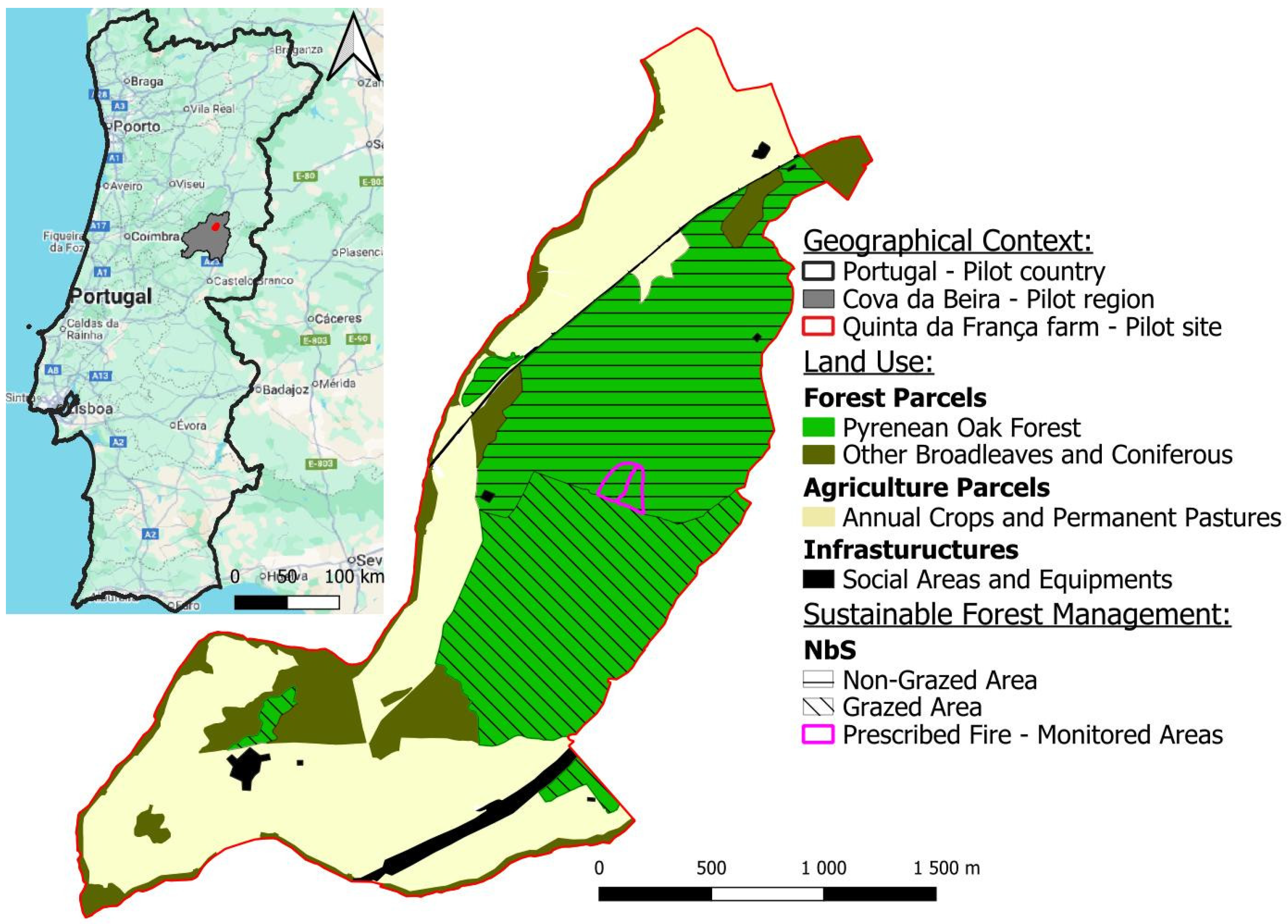



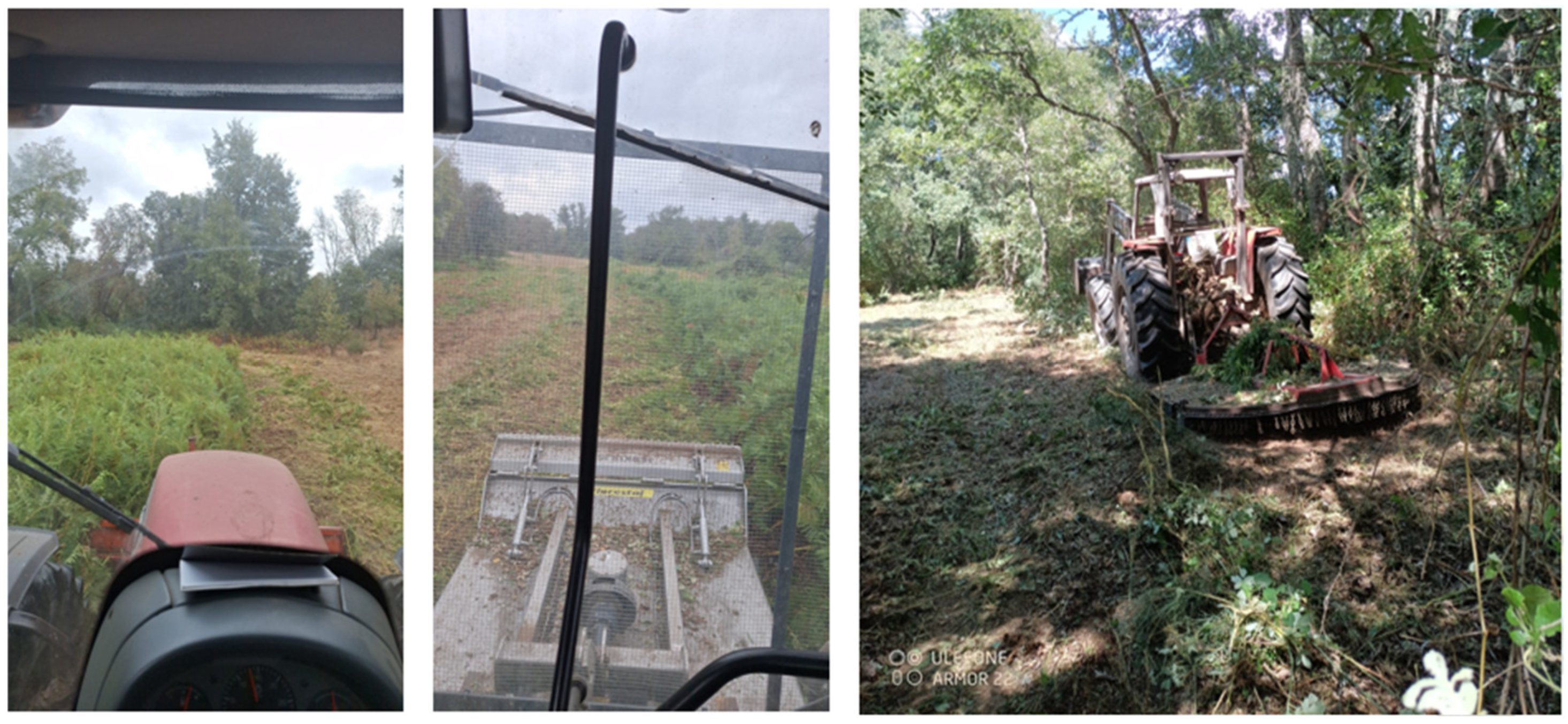
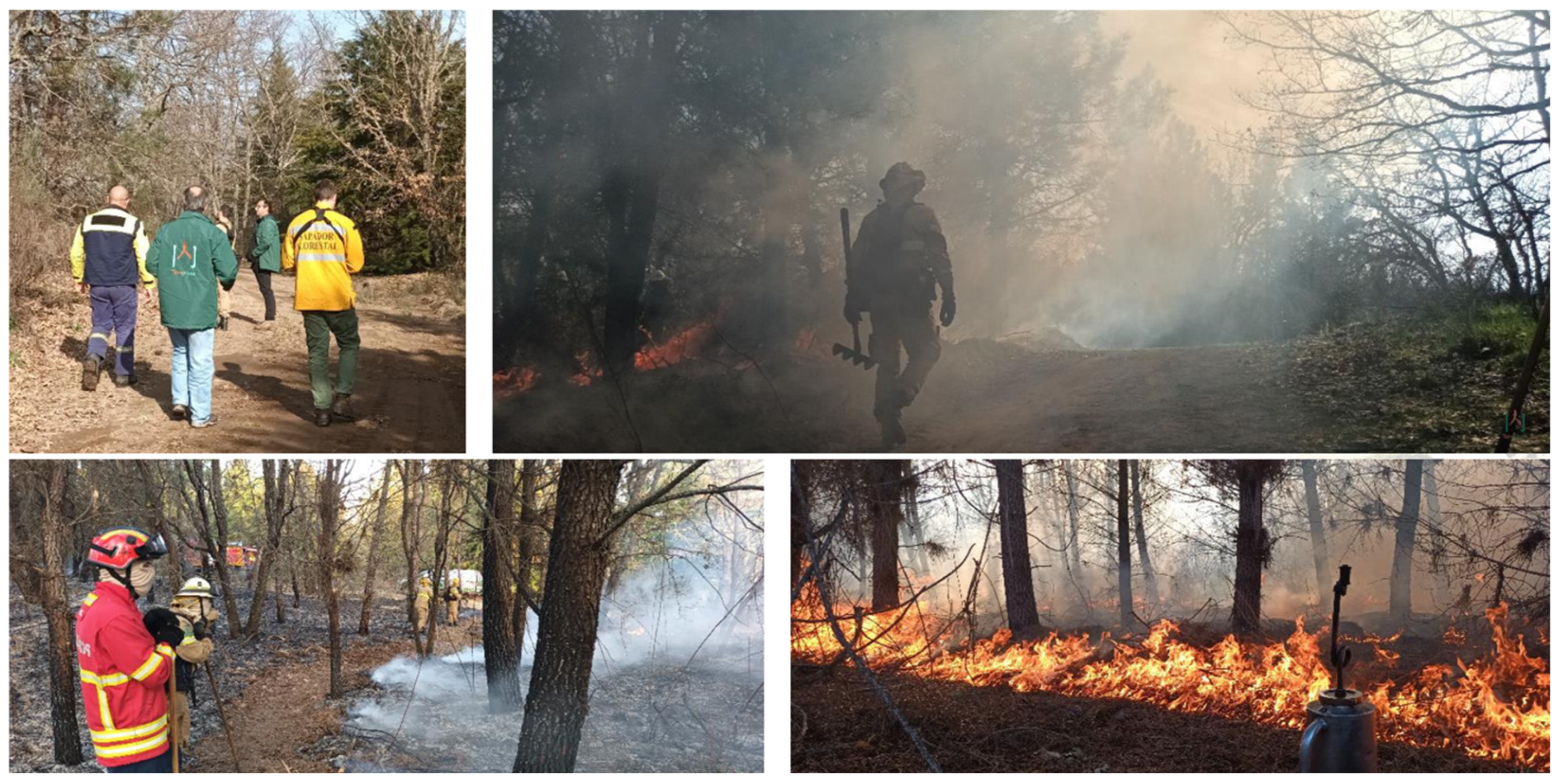
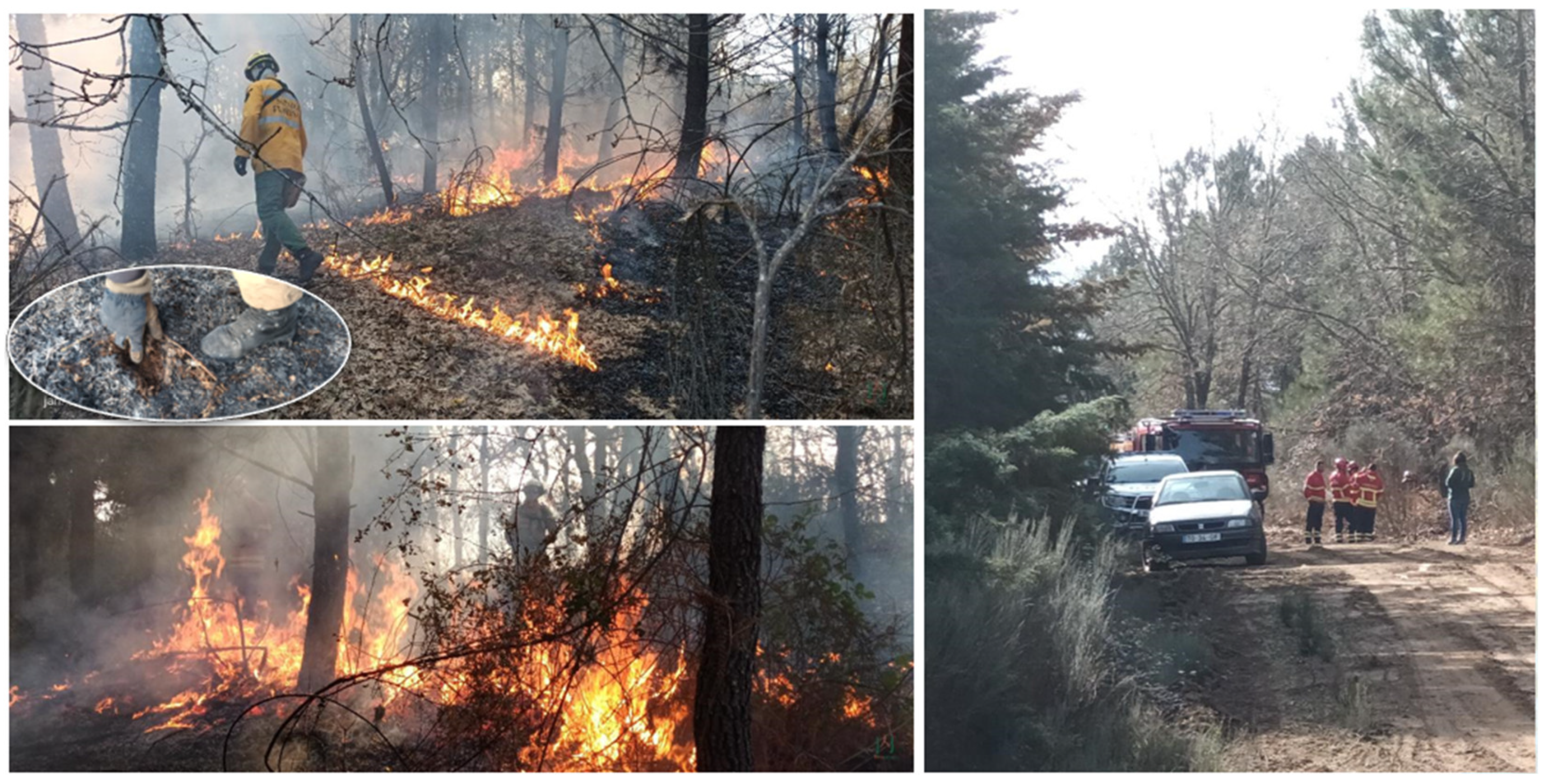
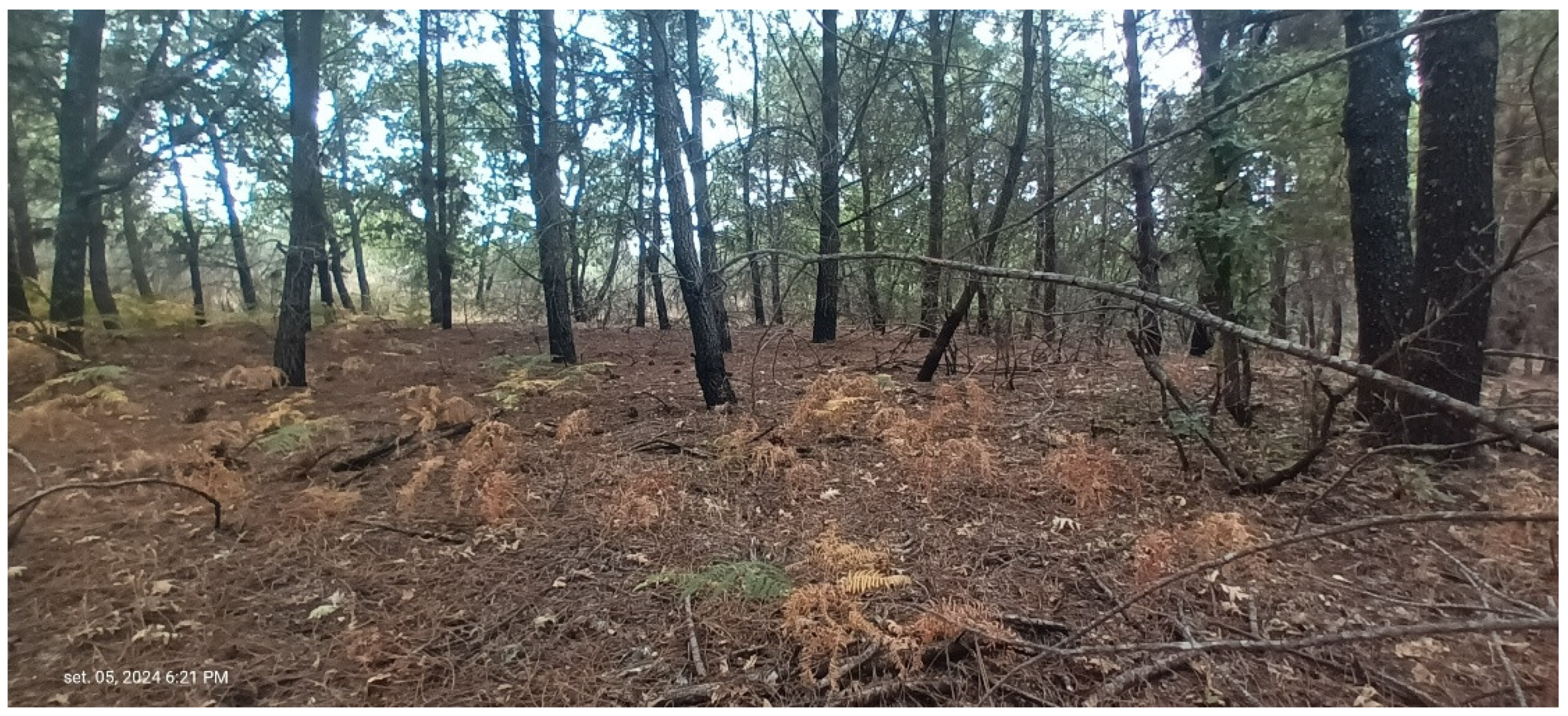
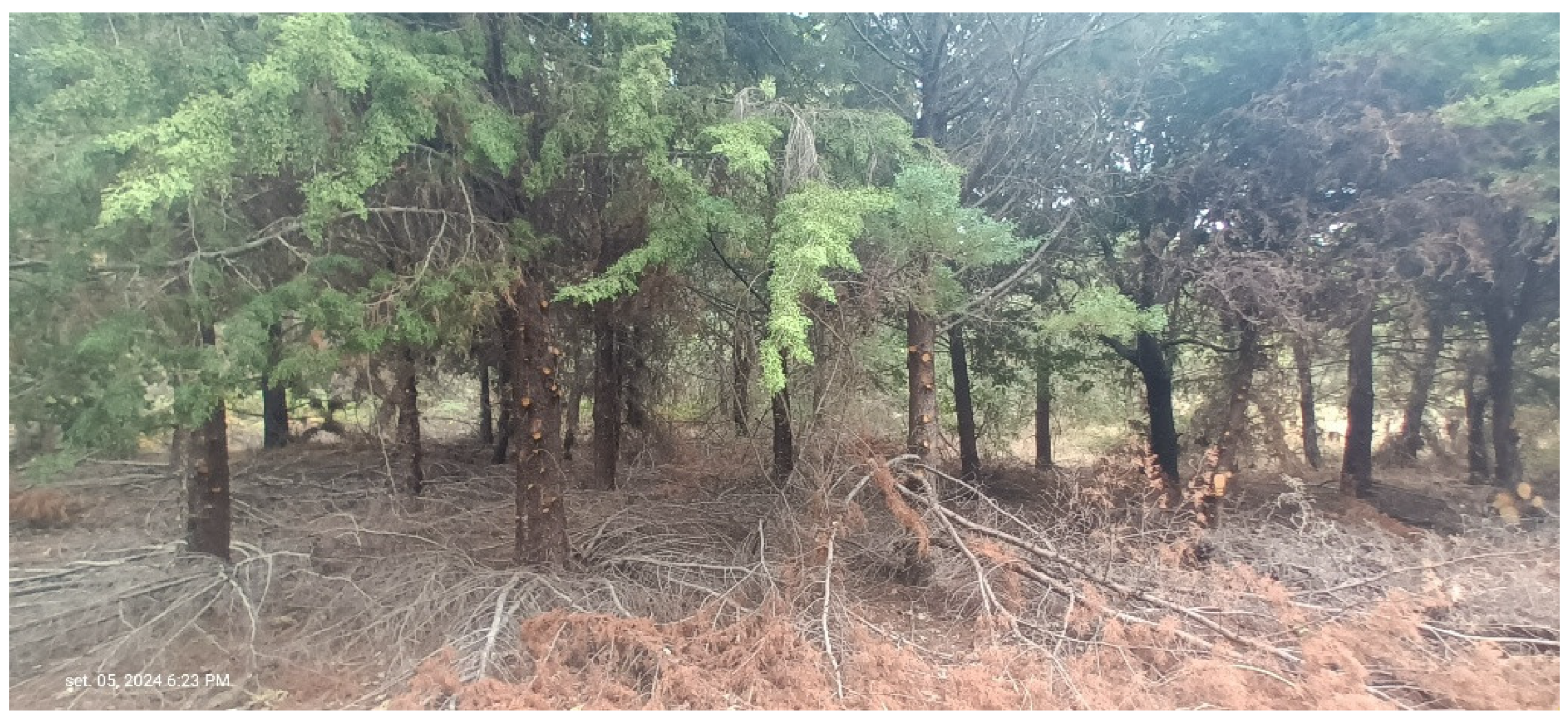

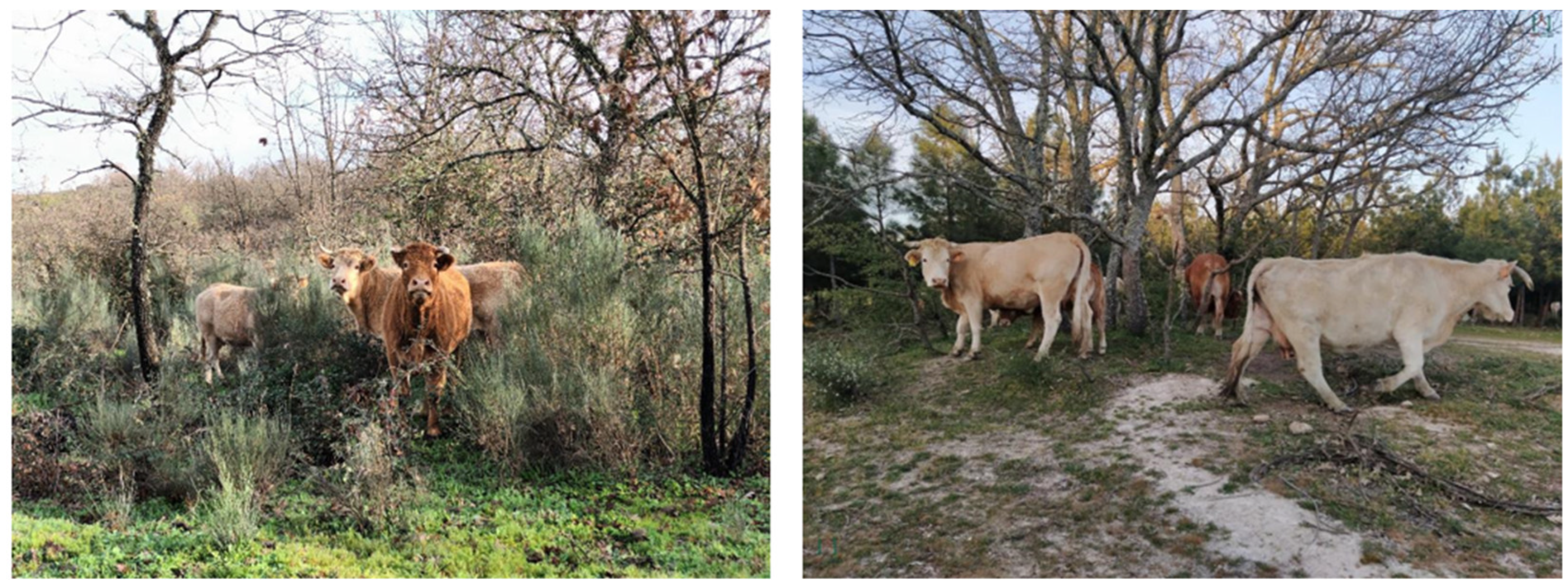
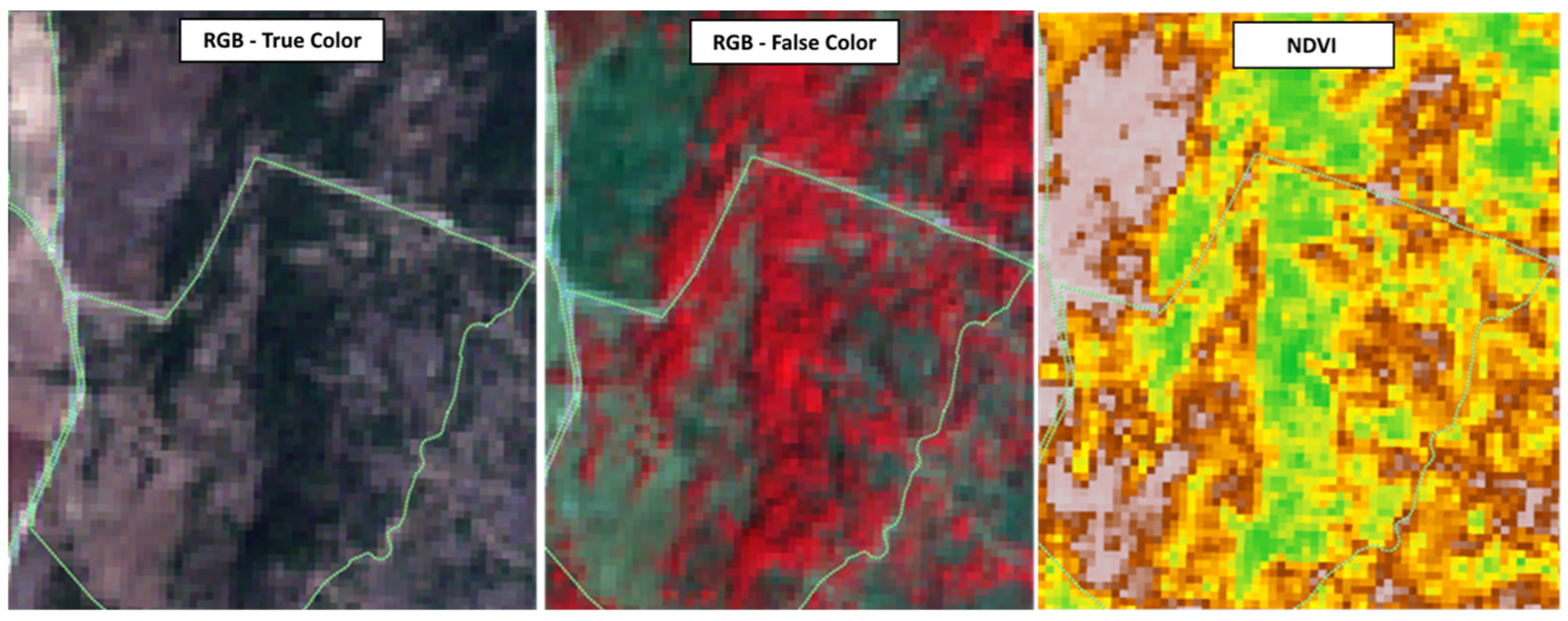
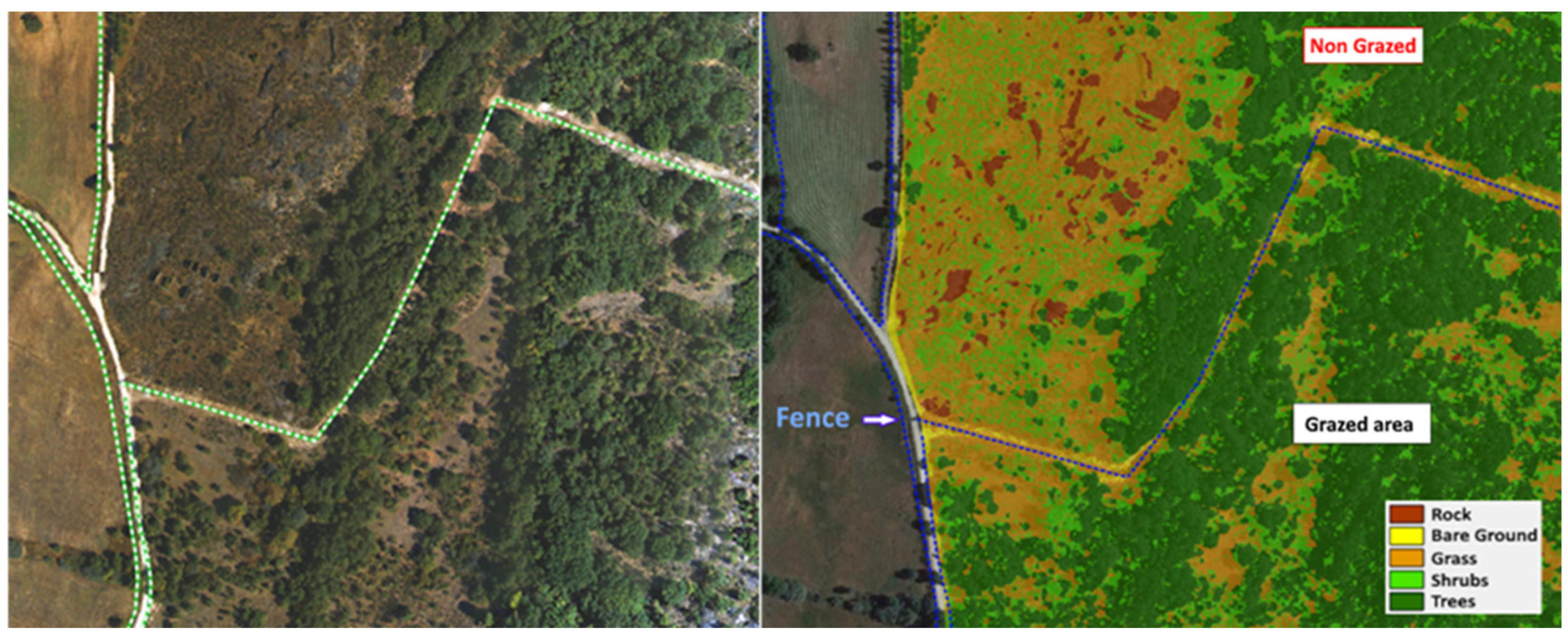

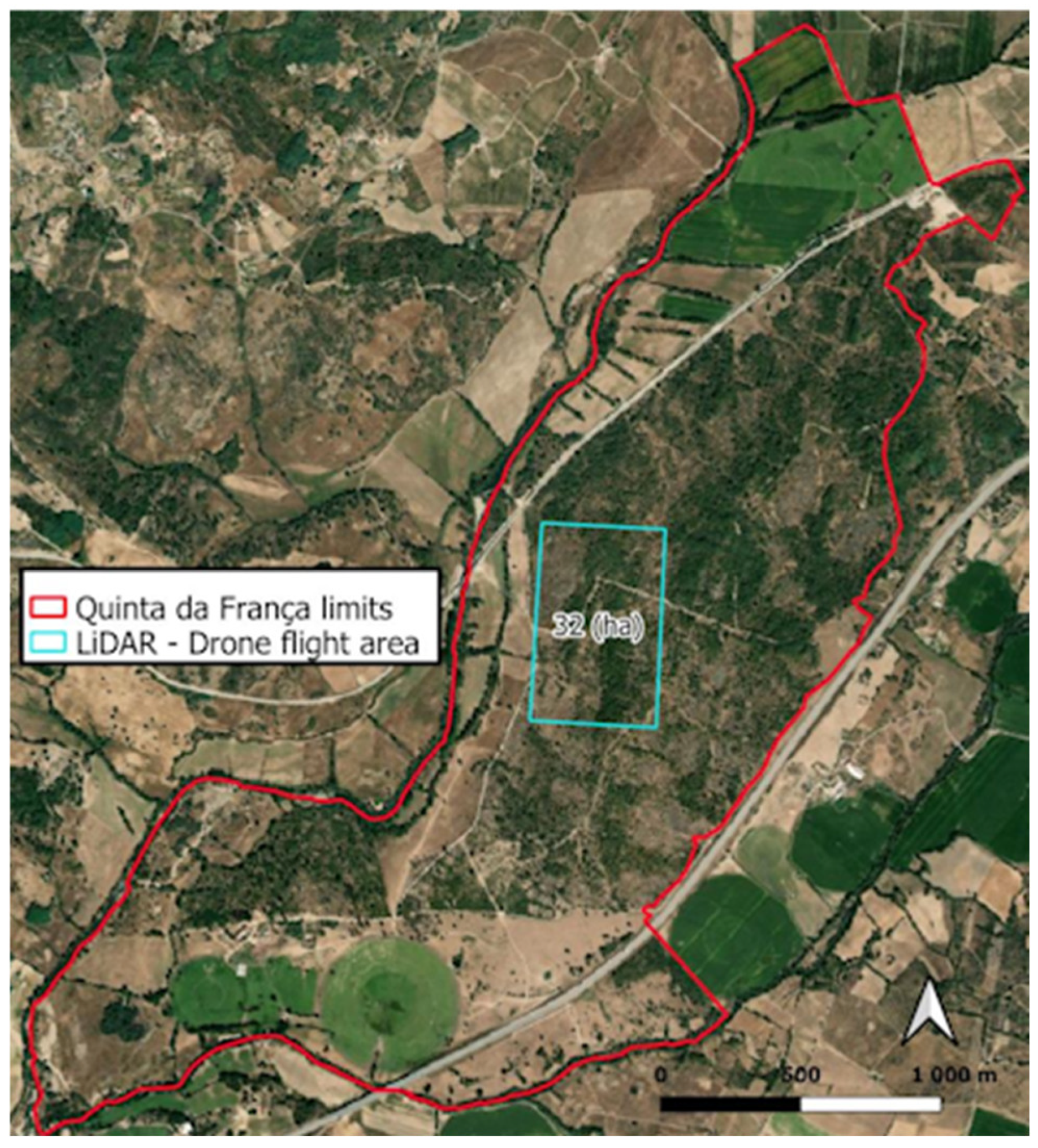

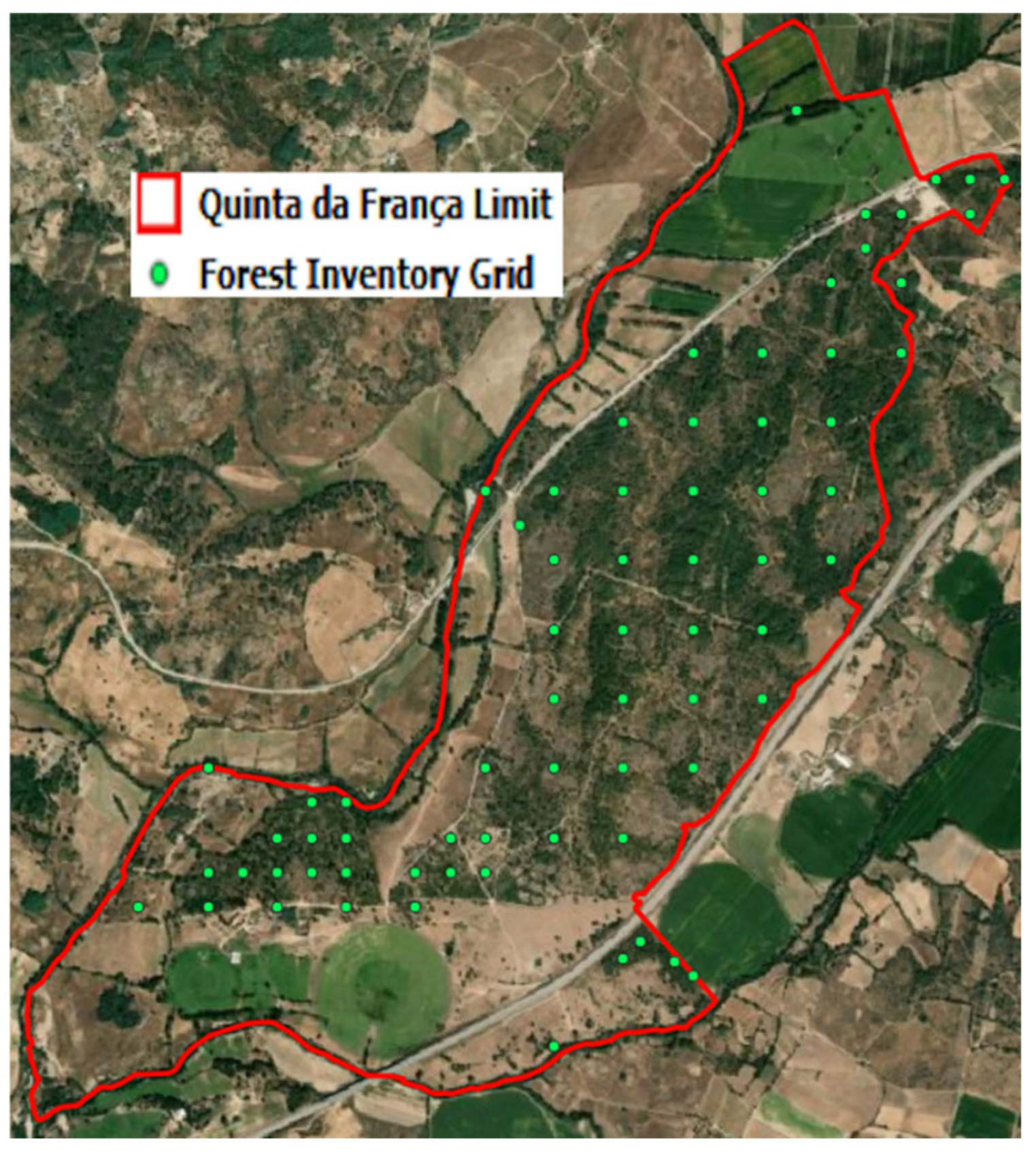
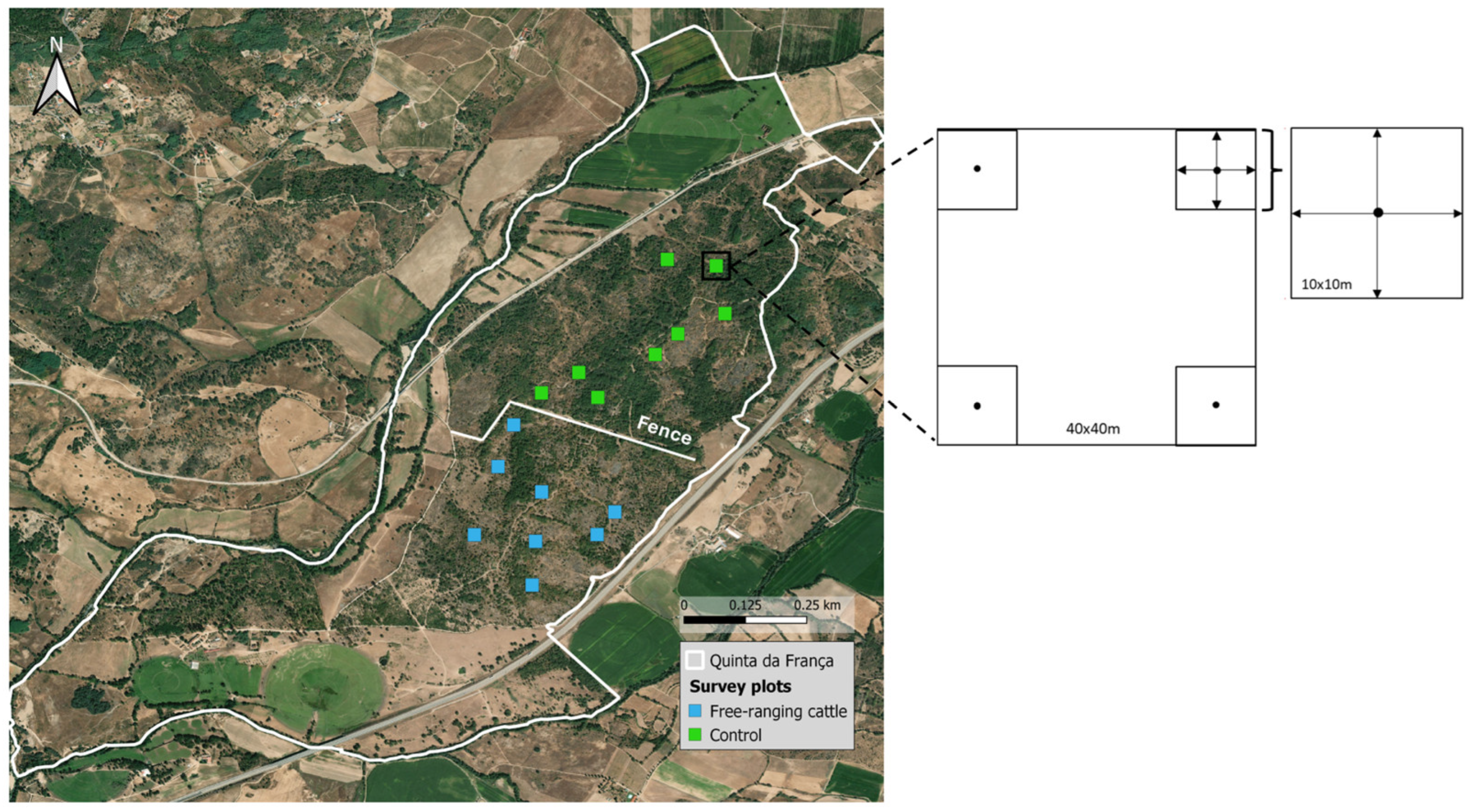
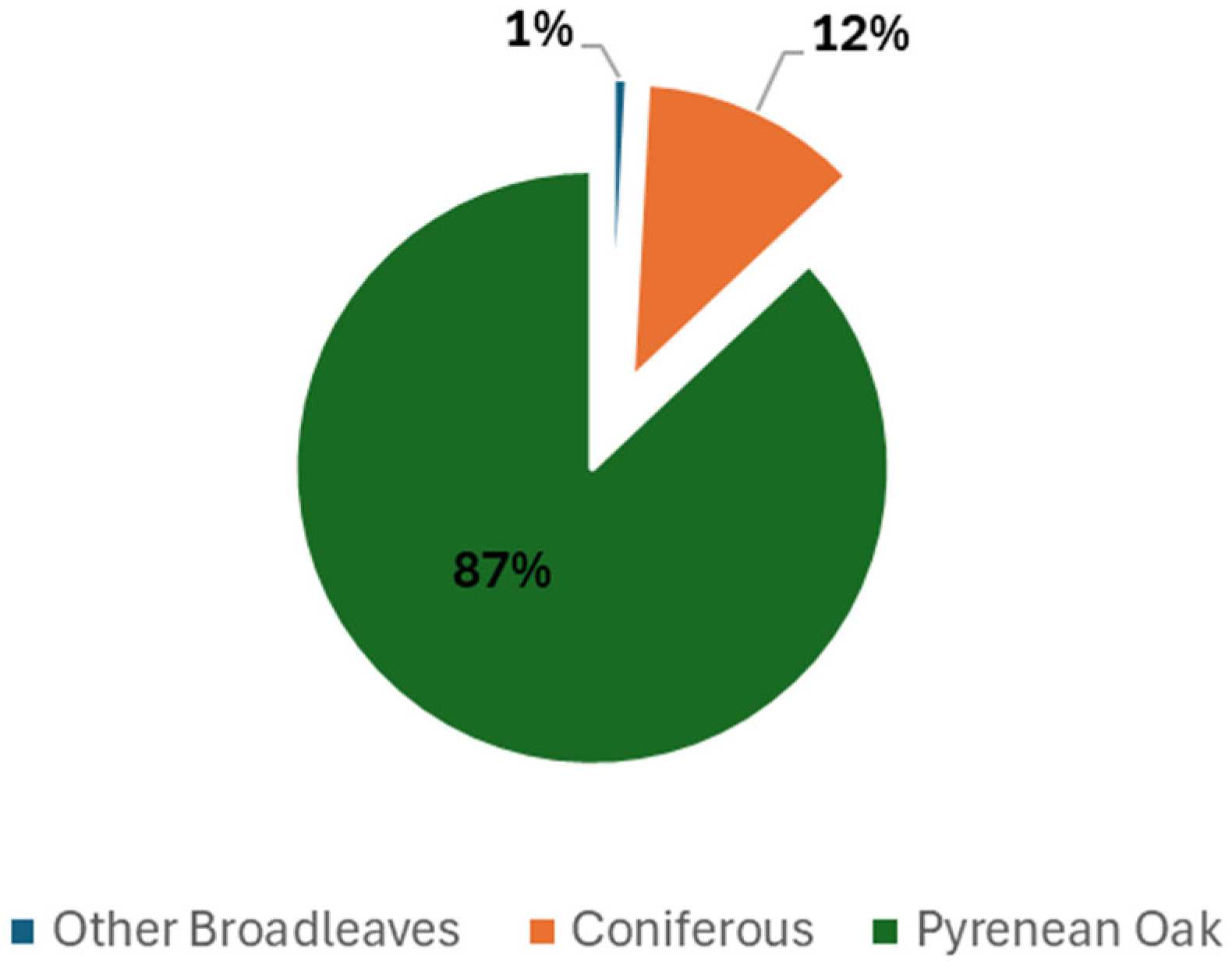






| RMSE | MAE | R2 |
|---|---|---|
| 0.837 | 0.618 | 0.537 |
| (a) Prescribed Fire Area | (b) Control Area | |||
|---|---|---|---|---|
| Land Cover | Area (ha) | % | Area (ha) | % |
| Rock | 0.01 | 0.5 | 0.00 | 0.3 |
| Bare Ground | 0.04 | 2.7 | 0.03 | 1.7 |
| Grass | 0.13 | 9.8 | 0.13 | 8.1 |
| Shrubs | 0.30 | 21.9 | 0.35 | 21.7 |
| Trees | 0.89 | 65.1 | 1.11 | 68.3 |
| Total | 1.37 | 100.0 | 1.62 | 100.0 |
| Sentinel-2 Tile | 2023 | 2024 |
|---|---|---|
| T29TPE | 4 January 2023 | 24 January 2024 |
| 3 February 2023 | 3 February 2024 | |
| 15 March 2023 | 23 April 2024 | |
| 19 April 2023 | 23 May 2024 | |
| 14 May 2023 | 12 June 2024 | |
| 23 June 2023 | 12 July 2024 | |
| 13 July 2023 | 16 August 2024 | |
| 12 August 2023 | 15 September 2024 | |
| 26 September 2023 | 5 October 2024 | |
| 1 October 2023 | 9 November 2024 | |
| 25 November 2023 | 9 December 2024 |
| Land Cover | 2023 | 2024 | ∆ |
|---|---|---|---|
| Grass | 4.8% | 1.1% | −3.7% |
| Shrubs | 1.5% | −2.5% | −4.1% |
| Trees | −6.4% | −6.8% | 0.4% |
Disclaimer/Publisher’s Note: The statements, opinions and data contained in all publications are solely those of the individual author(s) and contributor(s) and not of MDPI and/or the editor(s). MDPI and/or the editor(s) disclaim responsibility for any injury to people or property resulting from any ideas, methods, instructions or products referred to in the content. |
© 2025 by the authors. Licensee MDPI, Basel, Switzerland. This article is an open access article distributed under the terms and conditions of the Creative Commons Attribution (CC BY) license (https://creativecommons.org/licenses/by/4.0/).
Share and Cite
Domingos, T.; Kalapodis, N.; Sakkas, G.; Chandramouli, K.; Gama, I.; Proença, V.; Ribeiro, I.; Pio, M. Advancing Integrated Fire Management and Closer-to-Nature Forest Management: A Holistic Approach to Wildfire Risk Reduction and Ecosystem Resilience in Quinta da França, Portugal. Forests 2025, 16, 1306. https://doi.org/10.3390/f16081306
Domingos T, Kalapodis N, Sakkas G, Chandramouli K, Gama I, Proença V, Ribeiro I, Pio M. Advancing Integrated Fire Management and Closer-to-Nature Forest Management: A Holistic Approach to Wildfire Risk Reduction and Ecosystem Resilience in Quinta da França, Portugal. Forests. 2025; 16(8):1306. https://doi.org/10.3390/f16081306
Chicago/Turabian StyleDomingos, Tiago, Nikolaos Kalapodis, Georgios Sakkas, Krishna Chandramouli, Ivo Gama, Vânia Proença, Inês Ribeiro, and Manuel Pio. 2025. "Advancing Integrated Fire Management and Closer-to-Nature Forest Management: A Holistic Approach to Wildfire Risk Reduction and Ecosystem Resilience in Quinta da França, Portugal" Forests 16, no. 8: 1306. https://doi.org/10.3390/f16081306
APA StyleDomingos, T., Kalapodis, N., Sakkas, G., Chandramouli, K., Gama, I., Proença, V., Ribeiro, I., & Pio, M. (2025). Advancing Integrated Fire Management and Closer-to-Nature Forest Management: A Holistic Approach to Wildfire Risk Reduction and Ecosystem Resilience in Quinta da França, Portugal. Forests, 16(8), 1306. https://doi.org/10.3390/f16081306








